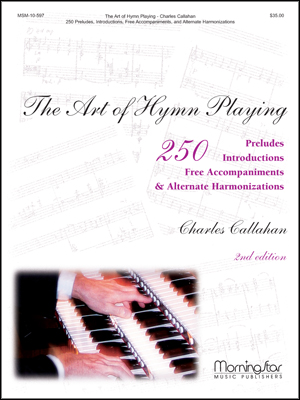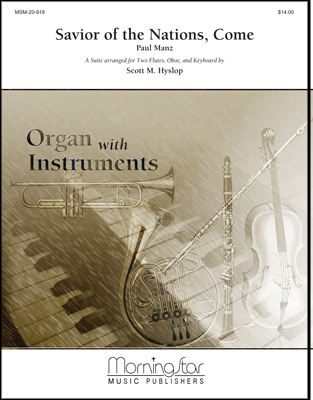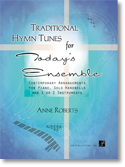- |
User Links
Christ Will Gather In His Own
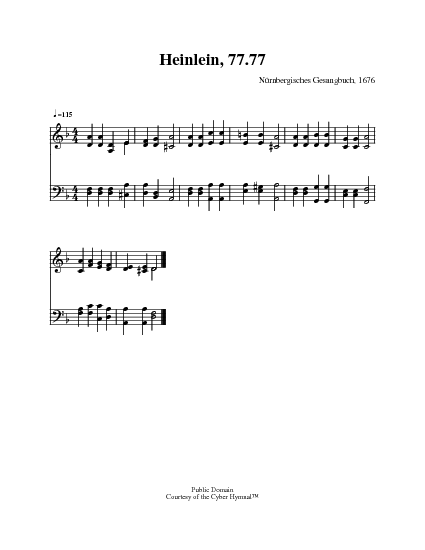
Christ will gather in His own, To the place where He is gone
Author: Nicolaus Ludwig, Graf von Zinzendorf; Author: Christian Gregor (1778); Translator: Catherine Winkworth (1863)Published in 22 hymnals
Printable scores: PDF, MusicXMLAudio files: MIDI
Representative Text
Christ will gather in His own
To the place where He is gone,
Where their heart and treasure lie,
Where our life is hid on high.
Day by day the voice saith, "Come,
Enter thine eternal home;"
Asking not if we can spare
This dear soul it summons there.
Had he ask'd us, well we know
We should cry, oh spare this blow!
Yes, with streaming tears should pray,
"Lord, we love him, let him stay!"
But the Lord doth nought amiss,
And since He hath order'd this,
We have nought to do but still
Rest in silence on His will.
Many a heart no longer here,
Ah! was all too inly dear;
Yet, O Love, 't is Thou doat call,
Thou wilt be our All in all.
Author: Nicolaus Ludwig, Graf von Zinzendorf
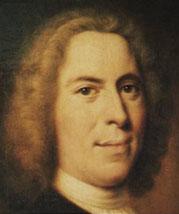 Zinzendorf, Count Nicolaus Ludwig, the founder of the religious community of Herrnhut and the apostle of the United Brethren, was born at Dresden May 26, 1700. It is not often that noble blood and worldly wealth are allied with true piety and missionary zeal. Such, however, was the case with Count Zinzendorf. In 1731 Zinzendorf resigned all public duties and devoted himself to missionary work. He traveled extensively on the Continent, in Great Britain, and in America, preaching "Christ, and him crucified," and organizing societies of Moravian brethren. John Wesley is said to have been under obligation to Zinzendorf for some ideas on singing, organization of classes, and Church government. Zinzendorf was the author of some two thousand hymn… Go to person page >
Zinzendorf, Count Nicolaus Ludwig, the founder of the religious community of Herrnhut and the apostle of the United Brethren, was born at Dresden May 26, 1700. It is not often that noble blood and worldly wealth are allied with true piety and missionary zeal. Such, however, was the case with Count Zinzendorf. In 1731 Zinzendorf resigned all public duties and devoted himself to missionary work. He traveled extensively on the Continent, in Great Britain, and in America, preaching "Christ, and him crucified," and organizing societies of Moravian brethren. John Wesley is said to have been under obligation to Zinzendorf for some ideas on singing, organization of classes, and Church government. Zinzendorf was the author of some two thousand hymn… Go to person page >Author: Christian Gregor
Gregor, Christian, son of Georg Gregor, a peasant living in the Silesian village of Dirsdorf, near Peilau, was born at Dirsdorf, Jan. 1, 1723. In 1742 he went to Herrnhut, where he was at first employed in tuition. He became leader of the music in the [Moravian] Brethren's congregation at Herrnhaag, in 1748, and in 1749 at Zeist; but in 1753 he returned to Herrnhut as cashier of the Brethren's Board of Direction. He was, in 1756, ordained diaconus, in 1767 presbyter, and in 1789 bishop of the Brethren's Church. On Nov. 6,1801, he attended a meeting, held at Herrnhut, of the Board of Direction of which he had been a member from 1764. Just as he entered his house at Berthelsdorf, near Herrnhut, he was struck with paralysis, and died that same… Go to person page >Translator: Catherine Winkworth
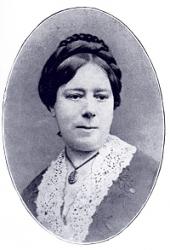 Catherine Winkworth (b. Holborn, London, England, 1827; d. Monnetier, Savoy, France, 1878) is well known for her English translations of German hymns; her translations were polished and yet remained close to the original. Educated initially by her mother, she lived with relatives in Dresden, Germany, in 1845, where she acquired her knowledge of German and interest in German hymnody. After residing near Manchester until 1862, she moved to Clifton, near Bristol. A pioneer in promoting women's rights, Winkworth put much of her energy into the encouragement of higher education for women. She translated a large number of German hymn texts from hymnals owned by a friend, Baron Bunsen. Though often altered, these translations continue to be used i… Go to person page >
Catherine Winkworth (b. Holborn, London, England, 1827; d. Monnetier, Savoy, France, 1878) is well known for her English translations of German hymns; her translations were polished and yet remained close to the original. Educated initially by her mother, she lived with relatives in Dresden, Germany, in 1845, where she acquired her knowledge of German and interest in German hymnody. After residing near Manchester until 1862, she moved to Clifton, near Bristol. A pioneer in promoting women's rights, Winkworth put much of her energy into the encouragement of higher education for women. She translated a large number of German hymn texts from hymnals owned by a friend, Baron Bunsen. Though often altered, these translations continue to be used i… Go to person page >Text Information
| First Line: | Christ will gather in His own, To the place where He is gone |
| Title: | Christ Will Gather In His Own |
| German Title: | Aller Glaubigen Sammelplatz |
| Author: | Christian Gregor (1778) |
| Author: | Nicolaus Ludwig, Graf von Zinzendorf |
| Translator: | Catherine Winkworth (1863) |
| Language: | English |
| Copyright: | Public Domain |
Notes
Deiner Kinder Sammelplatz. N. L.von Zinzendorf. [Burial of the Dead.] First appeared as No. 242 in the "Zweyter Anhang bis 1754," to the Kleine Brüder Gesang-Buch, London, 1754… [in a] form quite unsuited for public use. Though Knapp, in his 1845 edition of Zinzendorf’s Geistliche Lieder, p. 174, has tried to recast it without much success. It was probably written between 1749 and 1755. Lauxmann, in Koch, viii., 651, however says that it was written 1746, on the death and funeral of an only brother. In the Brüder Gesang-Buch of 1778 it was included as No. 1720, with stanzas ii., iii. omitted, and otherwise greatly altered and much improved by Christian Gregor. This text, which begins, "Aller Gl'aubgen Sammelplatz," is No. 1565 in the Berlin Geistliche Leider edition 1863. It is the usual funeral hymn among the German-speaking Moravians, and through the Württemberg Gesang-Buch of 1842 (No. 630) has become a great favourite in South Germany. Thus Koch, vii. 207, relates of Dr. C. G. Barth of Calw:—
On the 15th of November [1862], according to his own desire he was buried in the grave of Machtolf [his predecessor] at Mottlingen, where also his mother, who had died there in 1828, was at rest, to the strains of the hymn, an especial favourite of his, ‘Aller Glaub'gen Sammelplatz.'"
An additional verse, translated by Miss Winkworth as stanza iii., is founded on Zinzendorf’s stanza iv., and is thus given in Knapp's Evangelischer Lieder-Schatz, edition 1850, No. 2895…
It has been translated as:—
Christ will gather in His own, a fine translation from the 1778 text... by Miss Winkworth, in her Lyra Germanica, 2nd Series, 1858, p. 120, and in her Choral Book for England, 1863, No. 199. It was adopted unaltered as No. 191 in Hymns Ancient & Modern, 1801, and has since been'included in Kennedy, 1863; Church Hymns, 1871; Baptist Hymnal, 1879, and others; and in America in the College Hymnal, 1870; Baptist Service of Song, 1871; Evangelical Hymnal 1880, and others. It is given, in a slightly altered form, in Putnam's Singers and Songs of the Liberal Faith, Boston, U. S., 1875, and marked as an original hymn by W. C. H. Dall.
Another translation, from the text of 1778, is "All the saints will meet on high," in J. D. Burns's Memoir and Remains, 1869, p. 228. [Rev. James Mearns, M.A.]
--Excerpts from John Julian, Dictionary of Hymnology (1907)
Tune
NUN KOMM, DER HEIDEN HEILANDNUN KOMM DER HEIDEN HEILAND is a chorale derived from a chant. Among the simplest of the Lutheran repertoire, it is framed by identical lines–l and 4. Sing the entire hymn with antiphonal groups (the practice its original Latin author, Ambrose, strongly promoted). Sing some stanzas in unison and o…
HEINLEIN
AUS DER TIEFE (also called HEINLEIN) was published in the Nürnbergisches Gesang-Buch (1676-77) as a setting for Christoph Schwamlein's text based on Psalm 130 "Aus der Tiefe rufe ich" ("Out of the Depths I Cry"). In that songbook the tune was attributed to "M. H.," initials that are generally acce…
ST. THOMAS (Thorne)


 My Starred Hymns
My Starred Hymns